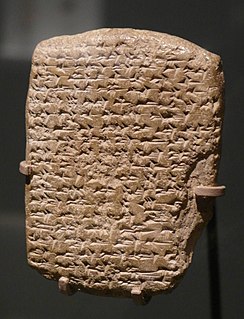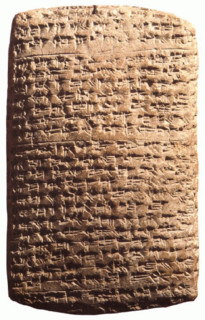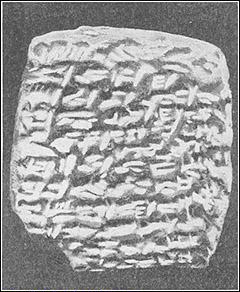NIN-UR.MAH.MEŠ, named the "Lady" of the Lions, was the author of two letters to the pharaoh, the King of Ancient Egypt, in the 1350–1335 BC Amarna letters correspondence. Her name is a representation of the original written script characters of Babylonian 'Sumerograms' , "NIN- + UR.MAH + (plural:MEŠ)", and means, "woman–lion–plural", namely: "Lady Lions".. The Amarna letters are mostly written in Akkadian cuneiform, with local words/phrases/etc due to various city-states or countries.

Amarna letter EA 252, titled: Sparing One's Enemies, is a square, mostly flat clay tablet letter written on both sides, and the bottom edge. Each text line was written with a horizontal line scribed below the text line, as well as a vertical left margin-line, scribe line on the obverse of the tablet. The letter contains 14 (15) lines on the obverse, continuing on the bottom tablet edge to conclude at line 31 on the reverse, leaving a small space before the final tablet edge. At least 4 lines from the obverse intrude into the text of the reverse, actually dividing the reverse into a top half and bottom half, and even creating a natural spacing segue to the reverse's text, and the story.

Amarna letter EA 365, titled Furnishing Corvée Workers, is a squarish, mostly flat clay tablet, but thick enough (pillow-shaped), to contain text that continues toward the right margin, the right side of the obverse side, and also to the right side of the reverse side of the tablet.

Amarna letter EA 364, titled Justified War, is a clay tablet letter from Ayyab, ruler of Aštartu, to Pharaoh Akhenaten.

Amarna letter EA 86, titled: Complaint to an Official, is a somewhat moderate length clay tablet letter from Rib-Hadda of city-state Byblos to Amanappa, an official at the court of the Pharaoh.

The cuneiform bad, bat, be, etc. sign is a common multi-use sign in the mid 14th-century BC Amarna letters, and the Epic of Gilgamesh. In the Epic it also has 5 sumerogram uses. From Giorgio Buccellati 'comparative graphemic analysis', of 5 categories of letters, the usage numbers of the bad sign are as follows: Old Babylonian Royal letters (71), OB non-Royal letters (392), Mari letters (2108), Amarna letters (334), Ugarit letters (39).

Amarna letter EA 144, titled: "Zimreddi of Sidon," is a square-shaped, mostly flat clay tablet letter written on both sides and the bottom edge. It is from a vassal state in Canaan, and is written by the 'mayor' of Sidon, the author of Amarna letter EA 144, and Amarna letter EA 145. Zimreddi is also referred to in a few other Amarna letters.

Amarna letter EA 271, titled: "The Power of the 'Apiru," is a moderately short, tallish, rectangular clay tablet letter, approximately 3 in wide x 4 in tall, from Milkilu the mayor/ruler of Gazru (Gezer), of the mid 14th century BC Amarna letters.

Amarna letter EA 270, titled: "Extortion," is an ovate-shaped, medium-sized, tall letter, approximately 3 in wide x 4 in tall, from Milkilu the mayor/ruler of Gazru (Gezer), of the mid 14th century BC Amarna letters.

Amarna letter EA 287, titled: "A Very Serious Crime," is a tall, finely-inscribed clay tablet letter, approximately 8 in tall, from Abdi-Heba the mayor/ruler of Jerusalem, of the mid 14th century BC Amarna letters. The scribe of his six letters to Egypt were penned by the "Jerusalem scribe"; EA 287 is a moderately long, and involved letter. The Amarna letters, about 300, numbered up to EA 382, are a mid 14th century BC, about 1350 BC and 20–25 years later, correspondence. The initial corpus of letters were found at Akhenaten's city Akhetaten, in the floor of the Bureau of Correspondence of Pharaoh; others were later found, adding to the body of letters.

Amarna letter EA 362, titled: "A Commissioner Murdered," is a finely-inscribed clay tablet letter from Rib-Haddi, the mayor/'man' of the city of Byblos,. Byblos, being a large coastal seaport Mediterranean city, was a city that was aligned with Egypt (Miṣri), and housed an Egyptian community. Rib-Haddi, as the city-state leader wrote the largest number of letters to the Pharaoh, in a sub-corpus of the 1350 BC Amarna letters.

Amarna letter EA 245, titled: "Assignment of Guilt," is a medium length clay tablet Amarna letter from Biridiya the governor-'mayor' of Magidda. It is letter number four of five from Biridiya.

Amarna letter EA 325, titled: "Preparations Completed (2)," is a shorter-length clay tablet Amarna letter from Yidya the governor-'mayor' of Ašqaluna-(Ashkelon). It is a letter addressing the Pharaoh in high terms, as well as stating the 'governor of Ašqaluna' is making preparations for the arrival of the Pharaoh's archer-army, the archers. EA 325 is a vassal-state letter, and has some similar appearances, for example appearing like letters EA 270 and EA 271.

Amarna letter EA 100, titled: "The City of Irqata to the King" is a short-, to moderate-length clay tablet Amarna letter from the city-state of Irqata,, written to the Pharaoh of Egypt. Only one other city sent a clay tablet Amarna letter to the Pharaoh, namely Tunip, letter EA 59, titled: "From the Citizens of Tunip".

Amarna letter EA 256, in short EA 256, catalogued under the title Oaths and Denials, is one of a total of about 350 so-called Amarna letters, belonging to an official correspondence dating to the mid-14th century BC. The initial corpus of letters were found at Akhenaten's city Akhetaten, on the floor of the Bureau of Correspondence of Pharaoh; others were later found, adding to the body of letters.

Amarna letter EA 323, titled: A Royal Order for Glass, is a smaller, square, mostly flat clay tablet letter written on both sides, but only half of the reverse; it is also written on the bottom, and is a letter from 'governor' Yidya, and is a short letter like many of his other Amarna letters, numbered EA 320 to EA 326.

Amarna letter EA 288, titled Benign Neglect, is a tall, finely-inscribed clay tablet letter, approximately 7.5 in tall x 4.5 in wide, broken into two pieces, from Abdi-Heba the mayor/ruler of Jerusalem, of the mid 14th century BC Amarna letters. The scribe of his six letters to Egypt were penned by the "Jerusalem scribe"; EA 288 is a moderately long, and involved letter.

Amarna letter EA 299, titled: "A Plea for Help", is a fairly short clay tablet Amarna letter from "governor" Yapahu of city-state Gazru. The clay tablet surface has been partially eroded, but the cuneiform is still mostly legible.

Amarna letter EA 75, titled: "Political Chaos", is a short to moderate length letter from Rib-Hadda, who wrote the largest number of Amarna letters in a sub-corpus, from the city-state of Byblos; Byblos contained an Ancient Egyptian colony, and was aligned with a few neighboring townsites.

Amarna letter EA 330, titled: "Dirt at the Feet of the King" is an ovate-(squarish)-shaped, small-sized letter, from Šipṭi-Ba'la the mayor/ruler of Lachish, of the mid 14th century BC Amarna letters.














